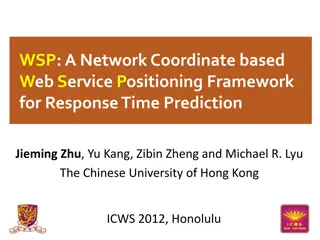Market-Driven Deployment Strategy for BGP Security
Incentives for enhancing BGP security are explored in this study, highlighting challenges and solutions for deployment. The importance of ISPs embracing S-BGP for financial gains and security benefits is emphasized. An outline of the strategy, model simulations, and practical recommendations are provided based on the analysis of internet routing protocols. The potential for making money through BGP security measures and tackling interception attacks are key components of the discussion.
Download Presentation

Please find below an Image/Link to download the presentation.
The content on the website is provided AS IS for your information and personal use only. It may not be sold, licensed, or shared on other websites without obtaining consent from the author.If you encounter any issues during the download, it is possible that the publisher has removed the file from their server.
You are allowed to download the files provided on this website for personal or commercial use, subject to the condition that they are used lawfully. All files are the property of their respective owners.
The content on the website is provided AS IS for your information and personal use only. It may not be sold, licensed, or shared on other websites without obtaining consent from the author.
E N D
Presentation Transcript
Columbia University New York, NY Nov. 17, 2011 Let the Market Drive Deployment A Strategy for Transitioning to BGP Security Phillipa Gill University of Toronto Michael Schapira Hebrew University of Jerusalem & Google NYC Sharon Goldberg Boston University
Incentives for BGP Security Insecurity of Internet routing is well known: S-BGP proposed in 1997 to address many issues but no deployment yet. Challenges to deployment are being surmounted: Political: Rollout of RPKI as a cryptographic root trust Technical: Lots of activity in the IETF SIDR working group, DHS, FCC etc. The pessimistic view: This is economically infeasible! Why should ISPs bother deploying S*BGP? No security benefits until many other ASes deploy! Worse yet, they can t make money from it! Our view: Calm down. Things aren t so bad. ISPs can use S*BGP to make money.
Outline Part 1: Background Part 2: Our strategy Part 3: Evaluating our strategy Model Simulations Part 4: Summary and recommendations
BGP: The Internets Routing Protocol (1) A simple model of AS-level business relationships. ISP 1 ISP 1 (peer) Level 3 Stub Level 3 (peer) stub (customer) Verizon Wireless ISP 2 ISP 2 (provider) 22394 (also VZW)
BGP: The Internets Routing Protocol (2) A stub is an AS with no customers that never transits traffic. (Transit = carry traffic from one neighbor to another) ISP 1 ISP Level 3 ISP Loses $ stub Verizon Wireless ISP 2 22394 85% of ASes are stubs! We call the rest (15%) ISPs.
BGP: The Internets Routing Protocol (3) Level3, VZW, 22394 66.174.161.0/24 ISP 1 VZW, 22394 66.174.161.0/24 Level 3 Verizon Wireless China Telecom 22394 66.174.161.0/24 22394 Paths chosen based on cost and length. 66.174.161.0/24
Traffic Attraction & Interception Attacks April 2010 : China Telecom intercepts traffic ChinaTel path is shorter ? ChinaTel 66.174.161.0/24 Level3, VZW, 22394 66.174.161.0/24 ISP 1 Level 3 Verizon Wireless China Telecom This prefix and 50K others were announced by China Telecom 22394 Traffic for some prefixes was possibly intercepted 66.174.161.0/24
Securing the Internet: RPKI Resource Public Key Infrastructure (RPKI): Certified mapping from ASes to public keys and IP prefixes. ? X RPKI: Invalid! Level3, VZW, 22394 66.174.161.0/24 ChinaTel 66.174.161.0/24 ISP 1 Level 3 Verizon Wireless China Telecom RPKI shows China Telecom is not a valid origin for this prefix. 22394 66.174.161.0/24
But RPKI alone is not enough! Resource Public Key Infrastructure (RPKI): Certified mapping from ASes to public keys and IP prefixes. ? Level3, VZW, 22394 66.174.161.0/24 ChinaTel, 22394 66.174.161.0/24 ISP 1 Level 3 Verizon Wireless China Telecom Malicious router can pretend to connect to the valid origin. 22394 66.174.161.0/24
To stop this attack, we need S*BGP (e.g. S-BGP/soBGP) (1) S-BGP [1997]: RPKI + Cannot announce a path that was not announced to you. VZW: (22394, Prefix) Level3: (VZW, 22394, Prefix) ISP 1: (Level3, VZW, 22394, Prefix) ISP 1 Level 3 Verizon Wireless China Telecom VZW: (22394, Prefix) Level3: (VZW, 22394, Prefix) 22394 VZW: (22394, Prefix) Public Key Signature: Anyone with 22394 s public key can validate that the message was sent by 22394.
To stop this attack, we need S*BGP (e.g. S-BGP/soBGP) (2) S-BGP [1997]: RPKI + Cannot announce a path that was not announced to you. VZW: (22394, Prefix) Level3: (VZW, 22394, Prefix) ISP 1: (Level3, VZW, 22394, Prefix) ISP 1 Level 3 Verizon Wireless China Telecom Malicious router can t announce a direct path to 22394, since 22394 never said 22394 ChinaTel: (22394, Prefix)
S*BGP must impact route selection It is not enough to sign and verify If we want security, S*BGP must impact BGP routing policy. How should security impact routing? Ideally: Prefer secure routes over all others Reality: Cost (business relationship) and path length may be preferred over security. Our strategy doesn't require prioritizing security over economics or path length security cost & performance
Challenges to S*BGP deployment RPKI is a necessity now on the horizon! Incentives for deployment? We ve seen similar problems before: Spread of innovations in social networks [Morris 2001, Kempe et al. 2003] Nodes adopt innovations when local utility exceeds a threshold Utility only depends on immediate neighbors! Network protocol adoption [Ratnasamy et al. 2005] Client demand for innovation creates financial incentive Relied on additional mechanisms to route traffic to upgraded networks S-BGP adoption [Chang et al. 2006] Assumed security benefits would be sufficient incentive Security is an intangible benefit
Overview S*BGP will necessarily go through a transition phase How should deployment occur? Our Goal: Come up with a strategy for S*BGP (S-BGP/soBGP) deployment. How governments & standards groups invest resources To enable a small set of ASes to create market pressure and drive voluntary deployment by many other ASes! Measure of success: number of ASes deploying S*BGP Does not quantify security improvement. We are currently working to quantifying the security during partial deployment.
Outline Part 1: Background Part 2: Our strategy Part 3: Evaluating our strategy Model Simulations Part 4: Summary and recommendations
How to deploy S*BGP globally? Pessimistic view: No local economic incentives; only security incentives Like IPv6, but worse, because entire path must be secure. Our view: S*BGP has an advantage: it affects route selection Even if it comes aftercost and length in decision process. This can drive traffic towards ISPs deploying S*BGP ISPs want to attract more traffic destined to customers Even if they don t care about security! [http://www.omninerd.com/articles/Did_China_Hijack_15_of_the_Internet_Rout ers_BGP_and_Ignorance] ISPs would be the ones forced to upgrade all of their equipment to support this initiative, but how would it benefit them? As commercial companies, if there is little to no benefit (potential to increase profit), why would they implement a potentially costly solution? The answer is they won t.
Our Strategy: 3 Guidelines for Deploying S*BGP (1) 1. Secure ASes should break ties in favor of secure paths Equally good paths to the destination? (in terms of cost and path length) Pick the secure one! Sprint
How this creates incentives Sprint needs to break the tie between equally good paths. 8359, 18608 38.101.185.0/24 13789, 18608 38.101.185.0/24 ISP ISP Sprint 8359 13789 $ AS 8359 delivers more traffic to his customer $ 18608 18608 18608 38.101.185.0/24 38.101.185.0/24 ISPs can use S*BGP to attract customer traffic & thus money
How this creates incentives Sprint uses securityto break the tie! 8359, 18608 38.101.185.0/24 13789: (18608, 38.101.185.0/24) Sprint: (13789, 18608, 38.101.185.0/24) Sprint 8359 13789 AS 8359 delivers less traffic to his customer $ $ 13789: (18608, 38.101.185.0/24) 18608 18608 38.101.185.0/24 ISPs can use S*BGP to attract customer traffic & thus money
Our Strategy: 3 Guidelines for Deploying S*BGP (1) 1. Secure ASes should break ties in favor of secure paths 2. Cheap S*BGP for stubs (e.g., simplex S*BGP) Bank of A Bank of A ISP1 A stub is an AS that has no customers. 85% of ASes are stubs! Boston U Boston U
Simplex S*BGP: Cheap S*BGP for Stubs A stub never transits traffic Only announces its own prefixes.. and receives paths from provider Sign but don t verify! (rely on provider to validate) 18608 38.101.185.0/24 Stub 18608 2 options for deploying S*BGP in stubs: 1. Have providers sign for stub customers. (Stubs do nothing) 2. Stubs run simplex S*BGP. (Stub only signs, provider validates) 1. No hardware upgrade required Sign for own prefixes, not ~300K prefixes Use ~1 private key, not ~36K public keys 2. Security impact is minor (we evaluated this): Stub vulnerable to attacks by its direct provider.
Our Strategy: 3 Guidelines for Deploying S*BGP (2) 1. Secure ASes should break ties in favor of secure paths 2. Cheap S*BGP for stubs (e.g., simplex S*BGP) Bank of A ISP1 Boston U (possibly with some government subsidies) 3. Initially, we need a few early adopters deploy S*BGP. (gov t incentives, PR, concern for security, etc). Who should these ASes be?
Outline Part 1: Background Part 2: Our strategy Part 3: Evaluating our strategy Model Simulations Part 4: Summary and recommendations
Model: S*BGP deployment process Initial state: Early adopter ASes have deployed S*BGP Their stub customers deploy simplex S*BGP Each round with state S: Compute utility for each ISP n given state S and S with ISP n deploying S*BGP If utility increases enough ISP n chooses to deploy S*BGP Termination: Process continues until no new ISP wants to change their deployment decision ISP n ISP n ISP n
How do we compute ISP utility? (1) Utilityn(S) = Customer traffic thru ISP n to dest d all dests Important Note: ISP utility does not depend on security. traffic Captures the idea that: ISPs profit by transiting traffic to their customers $ ISP n i.e., Weighted sum of source ASes routing through ISP n (on all edges) to customers only. $ customers
How do we compute ISP utility? (2) Utilityn(S) = Customer traffic thru ISP n to dest d all dests Let S be the state of the network (i.e. who deploys S*BGP) Can compute utility if we know S and ASes' routing policies Ranking function: 1. 2. Export Policy: 1. Export customer path to all neighbors. 2. Export peer/provider path to all customers. Prefer customer paths over peer paths over provider paths Prefer shorter paths 3. . 4. If secure, prefer secure paths Arbitrary tiebreak
Our Model: ISP S*BGP Decision Rule An ISP deploys S*BGP if it increases its utility by % Let S be the state of the network (i.e. who deploys S*BGP) ISP n decides to deploy iff ISP n Utilityn (S with n deploying) > (1 + ) Utilityn(S) is the deployment threshold, Models % profit that is reinvested in S*BGP deployment When an ISP deploys, it deploys simplex S*BGP in all its stubs.
Outline Part 1: Background Part 2: Our strategy Part 3: Evaluating our strategy Model Simulations Part 4: Summary and recommendations
Simulations Overview Large scale simulations! Each round, we compute: Paths between all pairs of ASes O(n2) once for each ISP O(n) (to evaluate revenue increase) Each iteration: O(n3) ! Run over the entire AS level topology, n=36,000 Custom algorithms, parallelized on 200-node DryadLINQ cluster Many simulations run to understand robustness Early adopter sets Deployment thresholds Traffic sourced by content providers AS Graphs [UCLA Cyclops + IXP] + Augmented topology
Case Study of S*BGP deployment Ten early adopters: Five Tier 1s: Sprint (AS 1239) Verizon (AS 701) AT&T (AS 7018) Level 3 (AS 3356) Cogent (AS 174) Five Popular Content Providers Google (AS 15169) Microsoft (AS 8075) Facebook (AS 32934) Akamai (AS 22822) Limelight (AS 20940) The five content providers source 10% of Internet traffic Stubs break ties in favor of secure paths Threshold = 5%. This leads to 85% of ASes deploying S*BGP (65% of ISPs)
Simulation: Market pressure drives deployment (1) Round 0 Round 1 Round 4 Sprint 13789 13789 8359 8359 18608 18608 Stub
Simulation: Market pressure drives deployment (2) Round 4 Round 5 Sprint 8342 13789 8359 18608 6731 6731 30733 Stub 50197 50197 Stub
Simulation: Market pressure drives deployment (3) Round 6 Round 7 Sprint 8342 8342 13789 8359 18608 9002 6731 6731 30733 Stub 50197 50197 41209 41209 43975 Stub Stub 39575 39575
Changes in Utility as Deployment Progresses (1) Sprint 8342 8359 6731 6731 30733 50197 50197 Let s zoom in on utility of each of these three ISPs
Changes in Utility as Deployment Progresses (2) ASes that deploy see initial gains But return to approx. their original utility ASes that do not deploy cannot gain traffic round
Tiebreak Sets: The Source of Competition (1) Sprint 13789 8359 18608 Sprint s tiebreak set to destination AS18608 is {AS 13789, AS 8359} Thus, these two ISPs compete for traffic!
Tiebreak Sets: The Source of Competition (2) 80% of tiebreak sets have only 1 path! 1. Average tiebreak set size is tiny = 1.18 ! 2. We also get ~same results (not shown) if only ISPs break ties on secure paths (i.e., 15% of ASes) Global deployment even if 96% of routing decisions are unaffected by security.
So who should be the early adopters? Theorem: Finding the optimal set of early adopters is NP-hard. Approximating this within a constant factor is also NP-hard. Small target set suffices for small threshold Higher threshold requires a larger target set.
Simplex S*BGP vs. Market-pressure Market pressure Few ISPs on. Most adoption via Simplex S*BGP Turning on just the content providers doesn t do much!
The Content Providers (CP) as early adopters? Cyclops AS graph has poor visibility into CP connectivity CP degree ~10x less than degree of largest Tier 1 ISP We augment graph so CP degree Tier 1 degree CP average path lengths drop from 3.5 to about 2.1 How much traffic is sourced by the 5 CPs? Sweep through values x = {10%, 20%, 33%, 50%} Tier 1s are usually more influential early adopters except if x is large (>33%) and threshold is small (<15%) Why? Tier 1s still transit more traffic than the CPs source, and can leverage simplex S*BGP
Outline Part 1: Background Part 2: Our strategy Part 3: Evaluating our strategy Model Simulations Part 4: Summary and recommendations
Summary and Recommendations How to create a market for S*BGP deployment? 1. Market pressure via S*BGP influence on route selection. 2. Many secure destinations via simplex S*BGP. Where should government incentives and regulation go? 1. Focus on early adopters; Tier 1s, maybe content providers 2. Subsidize ISPs to upgrade stubs to simplex S*BGP Other challenges and future work : ISPs need tools to predict S*BGP impact on traffic How to handle traffic shifts? BGP and S*BGP will coexist in the long run What does this mean for security?
Contact: phillipa@cs.toronto.edu http://www.cs.toronto.edu/~phillipa/sbgpTrans.html Thanks to Microsoft Research SVC and New England for supporting us with DryadLINQ.
Data Sources for ChinaTel Incident of April 2010 Example topology derived from Routeviews messages observed at the LINX Routeviews monitor on April 8 2010 BGP announcements & topology was simplified to remove prepending We anonymized the large ISP in the Figure. Actual announcements at the large ISP were: From faulty ChinaTel router: 4134 23724 23724 for 66.174.161.0/24 From Level 3: 3356 6167 22394 22394 for 66.174.161.0/24 Traffic interception was observed by Renesys blog http://www.renesys.com/blog/2010/11/chinas-18-minute-mystery.shtml We don t have data on the exact prefixes for which this happened. AS relationships: inferred by UCLA Cyclops























